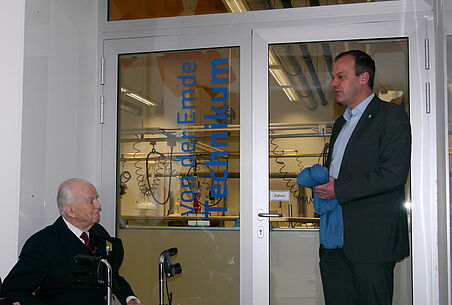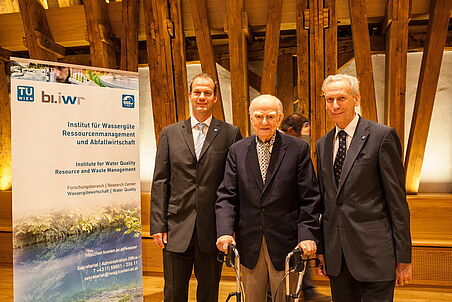About the Institute
Mission statement
Water quality management aims at insuring the provision of water of adequate quality for beneficial use and the protection of all waters from pollution in an economically and ecologically sustainable manner.
We develop engineering solutions as well as methods and concepts for water quality management based on scientific analysis of the interaction between anthropogenic activities and natural processes.
On this site the research units for Water Quality Management and Biology and Chemistry of Waters is described.
The following information can be downloaded:
![]() Folder of the research units for Water Quality Management & Biology and Chemistry of Waters
Folder of the research units for Water Quality Management & Biology and Chemistry of Waters
Research areas
analytical chemistry, water and wastewater analysis, water chemistry, integrated water quality management, water protection, water hygiene, environmental protection, environmental research, environmental remediation, modelling and simulation, wastewater treatment (biological and physico-chemical), sanitary environmental engineering, water supply, environmental technology, sustainable development and management, environmental management, landfill technology, river basin management, industrial water management, sewer systems, waste and resource management, material management, waste treatment technologies, material flow analysis, anthropogenic metabolism, raw material recovery (recycling),final sink.
The institute from 1815 to date
2020
29.09.2020 Opening and commissioning of the water research laboratory with new analytical laboratories (chemistry and molecular biology) and the new 'von der Emde Technikum´.
2018
The institute is renamed from
"Institute for Water Quality, Resource and Waste Management"
to
"Institute for Water Quality and Resource Management"
2015
On 6.11.2015 the new technical center, the "v.d. Emde - Technikum" was inaugurated. Prof. em. V.d.Emde (93 years at that moment) himself was present for the event. The new lab facility is equipped with modern experimental devices significantly improving the research infrastructure at the institute.
2014
On 27.5.2014 Jörg Krampe gave his inaugural lecture in the cupola hall of TU, 130 invited guests being present. With O.Univ.Prof. Dipl.-Ing. Dr.-Ing. Dr.h.c. Wilhelm von der Emde and O.Univ.Prof. Dipl.-Ing. Dr.techn. Dr.h.c. Helmut Kroißboth of his predesessors in heading the research aerea of water quality managment were present.
2013
Jörg Krampestarted his position as head of the research field of Water Quality Management, taking over from his predesessor Prof Kroiss.
2012
The long expected renovation of our rooms occured during summer 2012. During the construction works the research center moved to an interim location at Arsenal. On October 12th the new adapted rooms were officially inaugurated by the head of Institute Prof Brunner and the Dean of the faculty for civil engineering Prof. Eberhardsteiner.
In October Prof Kroiss retired from his position as head of the research center for Water Quality Management.
In July 2012 the hearing for the successor of Prof Kroiss took place.
2011
Due to restructuring within the Vienna University of Technology, the two departments "biology and Chemistry of Water" and "Water Quality Management" are merged to form the research center for "Water Quality Management" headed by Prof. Helmut Kroiss
2004
renaming of the „Institute for Water Quality and Waste Management“ to „ Institute for Water Quality, Resources and Waste Management“ with the following research centers:
- Water Quality Management (Helmut Kroiß)
- Biology and Chemistry of Water (first Norbert Matsché, currently Karl Svardal)
- Resources Management (Helmut Rechberger)
- Waste Management (Paul. H. Brunner)
2003
Chair of Resources Management was founded (headed by Helmut Rechberger).
1991
the Institute was renamed Institute for Water Quality and Waste Management. The Institute for Water Quality and Waste Management was reorganised and subdivided into the following groups:
- Water Quality Management (W.v.d.Emde, since 1987 headed by Helmut Kroiss)
- Chemistry and Biology of Water (headed by Norbert Matsché)
- Landschaftswasserbau (river engineering with respect to the landscape); since 1993 integrated within the Institute of Hydraulic Structures (Hubert Honsowitz)
- Waste and Materials Management (W. Kemmerling, since 1991 headed by Paul.H. Brunner).
since 1999 the group Informatics for Civil Engeneers (headed by Helmut Krzizek) is integrated
1980
the Institute of Water Supply, Sewage Purification and Prevention of Water Pollution and the Institute of River Engineering, Agricultural Water Engineering and Waste Management were fused into the Institute of Water Quality and Landschaftswasserbau (river engineering with respect to the landscape).
1975
the Technical University of Vienna was renamed University of Technology of Vienna as set out in the Austrian law of university organization.
1969
Kresser proposed a Chair and Institute of River Engineering and Agricultural Water Engineering (headed by W. Kemmerling), which took over Agricultural Water Engineering from the Institute of Professor Kresser. Finally, the Institute was renamed Institute of River Engineering, Agricultural Water Engineering and Waste Management and dealt with problems of waste management in Austria.
1964
Professor Kresser proposed to create the Chair and the Institute of Water Supply, Sewage Purification and Prevention of Water Pollution (headed by W.v.d.Emde), which took over Domestic Water Supplies from the Institute of Professor Kresser.
1959
W. Kresser was appointed Head of the Chair of Hydraulics, Hydrography, Agricultural Water Engineering and Domestic Water Supplies. As Head of the Central Hydrographical Office in Vienna Kresser primarily dealt with problems in the field of Hydrology.
1951
R.Pönninger was appointed university lecturer for "Purification of Waste Water and Sewage Utilization". Pönninger carried out basic experiments on trickling filters in 1938 in Beuthnen, where he also got his doctorate form. promoviert.
1940
the lectureship in Water Engineering III was changed into the Chair of Water Engineering III - water traffic engineering, domestic water supplies and agricultural water engineering. Kozeny succeeded in providing a transition between theoretical hydrodynamics and practical hydraulics. In particular through his book "Hydraulik - ihre Grundlagen und praktische Anwendung" (hydraulics - principles and practical application) Kozeny rose to international fame. Finally, in 1949, the Institute was renamed Institute of Hydraulics, Water Traffic Engineering, Domestic Water Supplies and Agricultural Water Engineering.
1935
J. Kozeny started to teach Water Engineering III.
1929
R. Halter retired and the Chair of Water Engineering was again reorganised:
- Water Engineering I - domestic water supplies, river engineering and hydroelectric power plants (F. Schaffernak)
- Water Engineering II - foundation and soil mechanics (K.v. Terzaghi)
- Water Engineering III - water supply, sewage disposal and agricultural water engineering (originally a lectureship, held by W. Viot)
Terzaghi, the founder of soil mechanics, gained international for recognition the Earthworks Laboratory of the Technical University of Vienna. At that time the Office of Construction Engineering of the Municipality of Vienna was headed by Professor Voit; from 1910 onwards Voit held lectures on Municipal Engineering and on the Encyclopaedia on Engineering Science for students of architecture and land surveying. In 1929, his university courses on water supply, sewage disposal and agricultural water engineering were made compulsory for all students of civil engineering.
1918
The Chair of Water Engineering was reorganised and subdivided into
- Water Engineering I (to be taught by F. Schaffernak)
- Water Engineering II - foundation, land drainage, waterway and harbour building as well as dam building and hydroelectric power plants (R. Halter).
Professor Schaffernak deserves great acknowledgement for having improved hydrology from the scientific point of view and for thus having provided the basis of Water Engineering; his book "Hydrgraphie" (hydrography) gained him international recognition.
1909
R. Halter was appointed to the Chair of Water Engineering. He was a member of the Austrian River Engineering Commission in charge of the river Danube and thus was primarily concerned with river engineering, harbour building as well as flood prevention schemes.
1882
Highway and Water Engineering were fused and taught by Professor J.G. Schön, who was particularly recognised for his concept of the Austrian Hydrographical Service. Around 1900, however, Highway and Water Engineering were definitely divided.
1872
the Vienna Polytechnic Institute was renamed Technical University of Vienna.
1867
Professor Stummer retired, and the Chair of Civil Engineering was subdivided into
- Building Mechanics and Theory of Bridge Building
- Highway and Railway Engineering and Structural Bridge Building
- Water Engineering (to be taught by M Bayer, ministerial engineer).
1865
the Vienna Polytechnic Institue was reorganised and subdivided into five Departments and Schools:
- General Department
- Chemical Technical School
- School of Mechanical Engineering
- School of Building and Construction (later on Architecture)
- School of Engineering (later on Civil Engineering).
1862
Professor Stummer ordered that his Chair be subdivided into "Civil Engineering" (to be taught by M. Wappler) and "Water and Highway Engineering".
1836
J. Stummer was appointed Professor of Civil and Water Engineering. Whereas Civil and Water Engineering had only been taught in the third and final year of the corriculum ("Civil Engineering" was taught during the winter semester, "Water engineering" during the summer semester - a daily one-hour unit together with drawing exercises), the Chair was finally subdivided into "Civil Engineering" and "Water and Highway Engineering" in 1842 and taught over the period of two academic years ever since that time. Professor Stummer was also concerned with the design and construction of important residential, industrial and administration buildings as well as with railway constructions.
1818
J.v.Kudriaffsky, head of the Office of Bridge Building and Water Engineering of Lower Austrian, was appointed to the Chair of Civil and Water Engineering, which covered both civil engineering and architecture. Since Professor Kudriaffsky was one of the founders of the Vienna School of Bridge Building his name is associated with a number of bridges that were built across the river Danube near Vienna.
1815
the first lectures were held at the Vienna Polytechnic Institute, as the University of Technology of Vienna was then called. The curriculum which was organised by J.Prechtl, then director of the Vienna Polytechnic Institute, provided for 8 core subjects:
Mathematics
- Physics
- general Chemistry
- Advanced Chemistry
- Mechanics and Mechanical Engineering
- Building Technology and Practical Geometry
- Civil and Water Engineering




